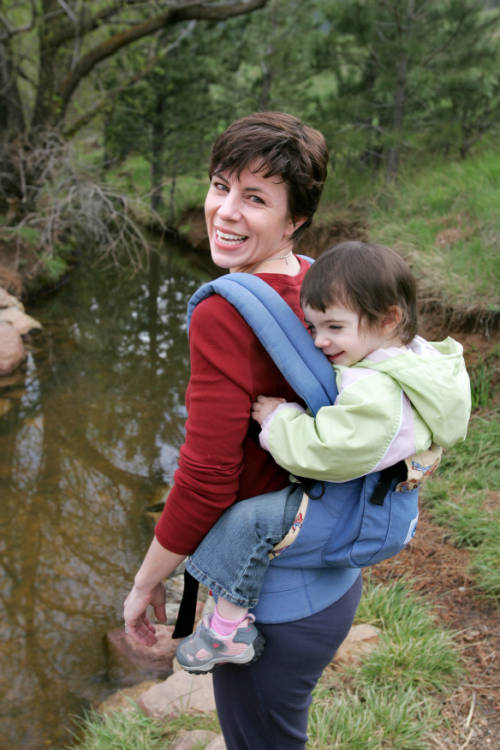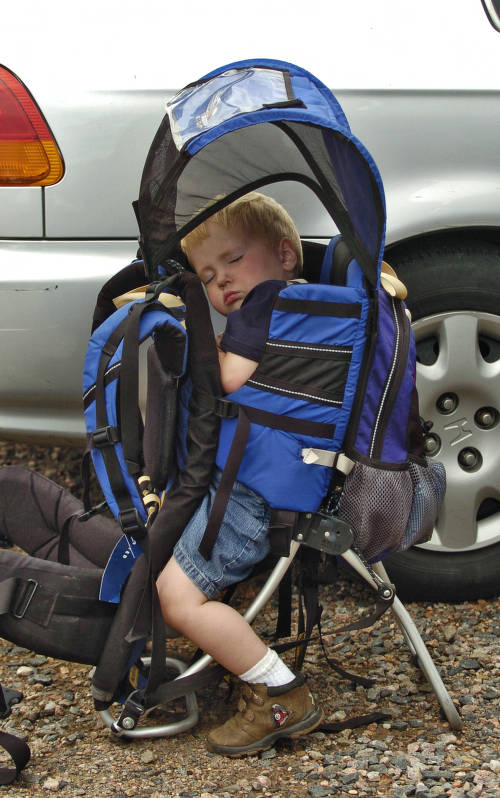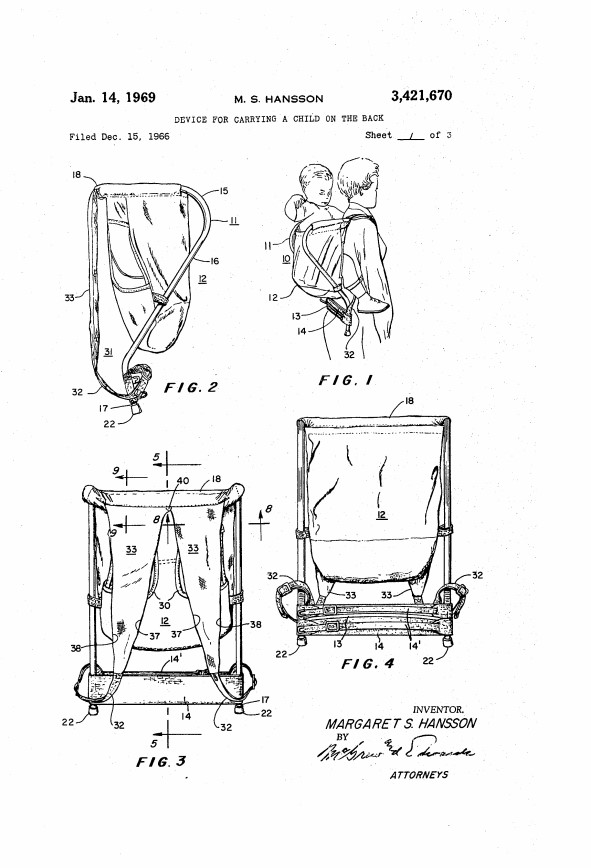
Story
Equipment for the Family Outdoors
Margaret Hansson’s Kiddie Carrier
When parents head to the trail with young children, they often equip themselves with child carriers to ease the way. Back in the 1960s, a Colorado-based outdoor company helped to commercialize the backpacks—with forward-facing seats for children and hip-belts for adults—so common today.

Lori Nichols and her daughter, Naomi, 23 months, model hiking products in Boulder on April 26, 2007, including the Ergo Baby Carrier (on Lori's back). Lori and her husband, Dan, own the store, Little Mountain Outfitters, which carries products to make hiking with kids a little easier.
What should “trail enthusiasts who have acquired small fry” do to balance their desire to hike with their family responsibilities, asked David Brower in the 1951 guidebook he edited for the Sierra Club. Beginning in the 1950s, the success of family wilderness outings depended on new specialty child carriers that helped parents tote their children over long distances. In response to the growing desire among fathers to “take a turn” carrying their children, outdoor companies developed specialized packs to pique the interests of men who might otherwise shy away from parenting products. In the late 1950s and early 1960s, outdoor companies developed a wide range of child carriers with names like Hike-a-Poose and Kiddie Pack. These packs, along with other growing commercial sources of children’s outdoor clothing and equipment, offer insight into the changing values of outdoor recreation in mid-century America.
While backpacks to carry children existed in various forms in the early twentieth century and before, it was a Colorado company that commercialized such a pack and made it available to a broad audience. Developed by Margaret (Meg) Hansson and her college classmate Gerry Cunningham, the Gerry Kiddie Carrier had a cantilevered weight distribution system and an S-curve frame that let children face forward. The patent for the Cunningham “child carrier” was as detailed as any for outdoor equipment. In the patent, granted in 1963, Cunningham explained that the pack was designed for adults to carry infants and small children while still having their hands free. “Devices of the small vehicular type”—or strollers—had the disadvantage of having a more limited range of use than simple walking, and required that the pusher use their hands.
While the patent images for child carriers included drawings of women wearing the packs, the language of the patent itself was broader. The child carrier, Cunningham explained, “will permit an adult to carry a child upon his back comfortably and with almost effortless ease.” By not identifying mothers specifically as the ones who would be offering “soothing and reassuring close body contact” with the “natural piggy-back position,” Cunningham opened a space for fathers as well. The careful distribution of load was the most important technical feature of this new child carrier that allowed both mothers and fathers to walk “long distances without tiring.” For a busy man who needed “his hands and mind free to perform other tasks” while still engaging with the child, this was capital-E Equipment.

Two year old Oliver Costello sleeps in a backpack Thursday afternoon August 11, 2005 in the parking lot of Alderfer 3-Sisters Park in Evergreen. He was there with his family from Denver and fell a sleep while on a hike. The Costello family hikes often in the foothill area.
While the Cunningham-Hansson kiddie carrier design was envisioned to help mothers and fathers bring their little ones on hikes, Hansson and Cunningham recognized that carriers for children had an appeal beyond outdoor recreation. Hansson created a spin-off company, Gerico, to sell those products. The packs were wildly popular. While Hansson sold only twelve in the first year of business, within a few years Gerico sold more than 300,000 per year. The product came at just the right time, Hansson later recalled, as people realized what activities they wanted to do outdoors.
By 1965, many different companies sold child carriers and most targeted women in their advertising. Even the patents suggested that the technical design of the packs were especially useful for women: Men might power through discomfort to spirit their child up a mountainside or around the neighborhood, but women needed ease of use to be able to tote their children in a similar manner.
Regardless of who ended up carrying the children, however, kiddie carriers sent an active message that children and families belonged in the wild. Meg Hansson reflected back in 1995, years after she had moved on to other business ventures, that scores of people would stop her and recall how they used her product. There are generations of children that have been carried in backpacks facing forward thanks to Hansson’s unique design. As Hansson put it, “That’s a lot of babies.”
Sources
Bradford Angier, Home in Your Pack: The Modern Handbook of Backpacking (Harrisburg, Pennsylvania: Stockpile Books, 1965)
Duncan Barnes, “Hiking Away to the Woods,” Sports Illustrated, May 31, 1965, http://www.si.com/vault/1965/05/31/607724/hiking-away-to-the-woods https://www.bizjournals.com/boston/blog/mass-high-tech/2002/03/longtime-entrepreneur-hansson-wont-slow-down.html
Gerald Cunningham patent, https://www.google.com/patents/US3097773
Margaret Hansson patent, https://www.google.com/patents/US3421670
Mountaineering Catalogs, 1967-1973, Carnegie Library for Local History, Boulder, CO
Todd Neff, “Longtime entrepreneur Hansson won’t slow down,” Boston Business Journal, March 11, 2002, https://www.bizjournals.com/boston/blog/mass-high-tech/2002/03/longtime-entrepreneur-hansson-wont-slow-down.html
Oral history interview with Margaret “Meg” Hansson, July 17, 1995, interview by Charles Aumiller, Carnegie Library for Local History, Boulder, CO

